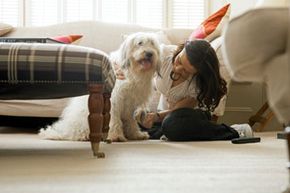It's not negotiable -- you have to take your dog into your vet's office for a full physical exam every year (and sometimes more often, especially if you have an older dog). However, that doesn't mean you shouldn't perform your own exams at home on a regular basis. If you're familiar with what's normal for your pooch, you'll be more likely to notice when something isn't right. You'll also know when you can take of problems yourself and when it's time to get professional help. Hopefully, you're already brushing your dog regularly, so that's a perfect time to do a home exam. He'll enjoy getting extra attention from you, and it's a good opportunity to spend some quality time together. Begin when your dog is a puppy or when you first get him, so he'll be used to being handled.
To start off, check out your dog's coat. Look for things like dry skin, dandruff, fleas or "flea dirt" (a nice way of saying flea feces). If you're worried that your dog has fleas, brush out his coat over a white piece of paper or a light-colored towel. If you see any little black specks, moisten them with a drop of water or smear them with a damp cotton ball. If you see a red streak, then it's definitely flea dirt, and your dog has a flea infestation. You can remove fleas from his coat using a fine-toothed flea comb. Dip the flea comb in a bowl of soapy water; the fleas will drown in the water, and the soap holds them under and keeps them from jumping out of the bowl. Although you can get rid of the fleas that are currently on your dog, more will just jump right back on him unless you use a preventive flea treatment. There are over-the-counter versions available, but generally, they're not very effective (and flea collars can be dangerous). Consult with your vet to find out which one is best for your dog.
Advertisement
Read on to find out what else you should be looking for when performing a physical exam of your dog -- including why it's important to smell his ears!



